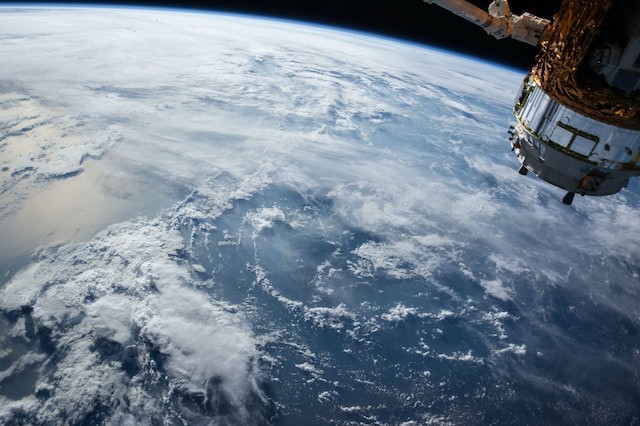According to researchers, oxygen levels in the Earth's atmosphere "fluctuated wildly" one billion years ago, creating conditions that could have accelerated the development of early animals.
How fluctuating oxygen levels may have accelerated animal evolution
 (Photo : NASA via Getty Images)
(Photo : NASA via Getty Images)

Scientists believe atmospheric oxygen evolved in three stages, beginning with the Great Oxidation Event around two billion years ago when oxygen first appeared in the atmosphere, as per ScienceDaily.
The third stage occurred around 400 million years ago when atmospheric oxygen reached current levels.
What is unknown is what happened during the second stage, known as the Neoproterozoic Era, which began approximately one billion years ago and lasted approximately 500 million years, during which time early forms of animal life emerged.
Scientists have attempted to answer the question, "Was there anything extraordinary about the changes in oxygen levels in the Neoproterozoic Era that may have played a pivotal role in the early evolution of animals?" Did oxygen levels rise suddenly or gradually?
Early animal fossils, known as Ediacaran biota, multi-celled organisms that required oxygen, have been discovered in sedimentary rocks dating back 541 to 635 million years.
A research team led by the University of Leeds and supported by the Universities of Lyon, Exeter, and UCL used measurements of the different forms of carbon, or carbon isotopes, found in limestone rocks taken from shallow seas to try to answer the question.
The researchers were able to calculate photosynthesis levels that existed millions of years ago and infer atmospheric oxygen levels based on the isotope ratios of the different types of carbon discovered.
They were able to produce a record of oxygen levels in the atmosphere over the last 1.5 billion years as a result of the calculations, which tells us how much oxygen would have been diffusing into the ocean to support early marine life.
Dr. Alex Krause, the project's lead scientist and a biogeochemical modeler who completed his Ph.D. in the School of Earth and Environment at Leeds, said the findings provide a new perspective on how oxygen levels on Earth are changing.
"The early Earth was anoxic, devoid of atmospheric oxygen, for the first two billion years of its existence," he continued, "and then oxygen levels began to rise, which is known as the Great Oxidation Event."
Scientists previously believed that after the Great Oxidation Event, oxygen levels were either low and then spiked just before the first animals evolved, or that oxygen levels were high for many millions of years before the animals appeared.
For a long time before the emergence of animal life, there was an oscillation between high and low oxygen levels.
We're seeing periods when the ocean environment, where early animals lived, had plenty of oxygen, and then periods when it didn't."
Dr. Benjamin Mills, who directs Leeds' Earth Evolution Modelling Group and oversaw the project, stated: "This periodic change in environmental conditions would have resulted in evolutionary pressures, causing some life forms to become extinct and others to emerge.
The oxygenated periods, according to Dr. Mills, expanded what is known as "habitable spaces" parts of the ocean where oxygen levels would have been high enough to support early animal life forms.
Read more: Eastern Pacific Hurricane: Tropical Storm Kay Expected to Hit Mexico, Southwest US This Week
The Oxygen Levels on Earth Can Influence Its Climate
Oxygen currently accounts for about 21% of the gases in the Earth's atmosphere, but this level has fluctuated over time, as per The Smithsonian Magazine.
There was very little oxygen in the atmosphere for the first couple of billion years.
Then, about 2.5 billion years ago, photosynthetic cyanobacteria began to add oxygen to the atmosphere.
"Photosynthesis generates oxygen as a byproduct. "It is consumed through respiration," explains Chris Poulsen, a climate scientist at the University of Michigan and lead author of the study published today in Science.
Poulsen and his colleagues were studying the late Paleozoic climate and plants when they began discussing whether oxygen levels might have influenced climate in the past.
Because studies have shown that atmospheric carbon dioxide has been the primary climate driver throughout deep time, most people assumed that oxygen's role was negligible.
However, carbon-based computer models have not been able to explain everything in the record.
For example, the Cenomanian, a late Cretaceous age characterized by high carbon dioxide and soaring temperatures, but models of this time typically produce polar temperatures and precipitation rates that are too low when compared to data from the paleogeologic record.
So Poulsen began modifying a climate model to test the oxygen hypothesis, and the results revealed that changes in oxygen concentration did have an effect via a series of feedbacks.
According to the researchers, incorporating oxygen's effects during other time periods could lead to more accurate models of the planet's past.
However, Poulsen warns that the study has no bearing on what is known about the Earth's current climate.
Today's climate is changing as levels of greenhouse gases such as carbon dioxide and methane rise dramatically-oxygen plays no role.
Related article: Hurricane Orlene Forecasted to Impact Western Mexico and Southwest United States
© 2024 NatureWorldNews.com All rights reserved. Do not reproduce without permission.

![Tsunami Hazard Zones: New US Map Shows Places at Risk of Flooding and Tsunamis Amid Rising Sea Levels [NOAA]](https://1471793142.rsc.cdn77.org/data/thumbs/full/70325/280/157/50/40/tsunami-hazard-zones-new-us-map-shows-places-at-risk-of-flooding-and-tsunamis-amid-rising-sea-levels-noaa.jpg)



